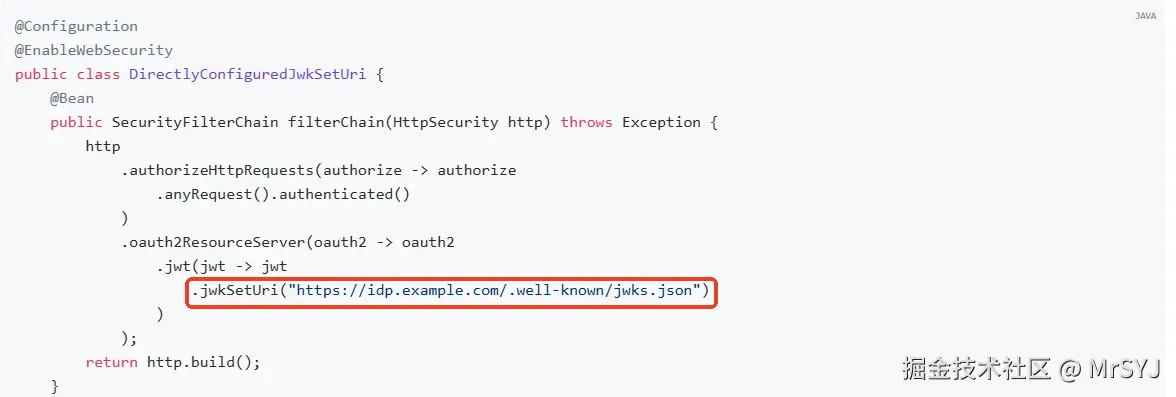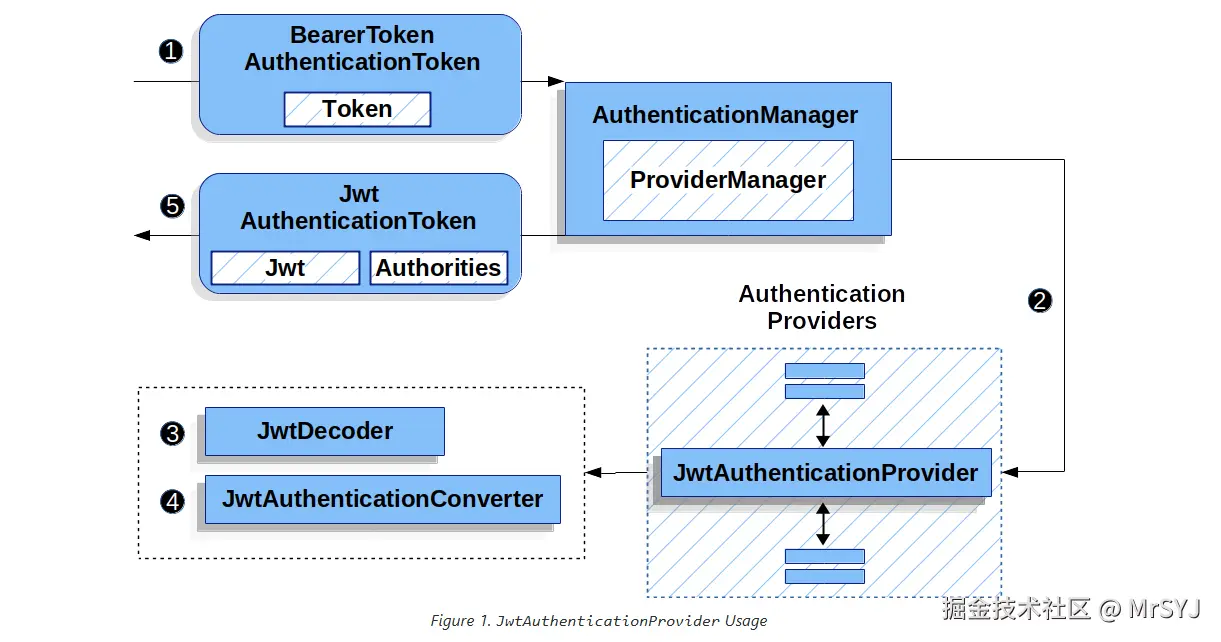📌 资源服务器的作用:
资源服务器负责保护你的 API 接口 ,只允许携带有效 JWT Token 的请求访问。它不负责登录或发放 Token,而是验证 Token 的有效性(比如签名、过期时间、颁发者等)。
当你的微服务项目引入了OAuth2 Resource Server的依赖,框架会为应用做两件事
- 创建一个JwtDecoder。
- 自动为你配置一个过滤器链,在过滤器链中增加了
BearerTokenAuthenticationFilter用来验证token的有效性。
xml
<!-- OAuth2 Resource Server -->
<dependency>
<groupId>org.springframework.boot</groupId>
<artifactId>spring-boot-starter-oauth2-resource-server</artifactId>
</dependency>应用也可以选择自己暴露一个SecurityFilterChain bean,否则框架就会采用默认的配置。
scss
/**
* 资源服务器配置
* If the application doesn't expose a SecurityFilterChain bean, then Spring Boot will expose the above default one.
*
* @param http
* @return
* @throws Exception
*/
@Bean
public SecurityFilterChain filterChain(HttpSecurity http) throws Exception {
http
.authorizeHttpRequests(authorize -> authorize
.anyRequest().authenticated()
)
.oauth2ResourceServer((oauth2) -> oauth2.jwt(Customizer.withDefaults()));
return http.build();
}🔍 一、JwtDecoder 是什么?
java
@FunctionalInterface
public interface JwtDecoder {
/**
* Decodes the JWT from it's compact claims representation format and returns a
* {@link Jwt}.
* @param token the JWT value
* @return a {@link Jwt}
* @throws JwtException if an error occurs while attempting to decode the JWT
*/
Jwt decode(String token) throws JwtException;
}JwtDecoder 是 Spring Security 提供的一个接口,它的核心作用是:
✅ 接收一个 JWT 字符串(比如
eyJhbGciOiJIUzI1Ni...),验证它的签名和有效期,并把它解析成一个Jwt对象(包含 header、payload、claims 等信息)。
所以资源服务器要想知道如何去验证解析客户端带来的token,只能依托给JwtDecoderjwt解析器。
当你在资源服务器中启用了jwt,但是却没有在容器中配置JwtDecoder的Bean,服务启动的时候就会报错,提示让我们配置一个JwtDecoder来解析即将到来的token
启用jwt:
java
http.oauth2ResourceServer((oauth2) -> oauth2.jwt(Customizer.withDefaults()));控制台报错信息: Method filterChain in com.emrubik.system.security.config.ResourceServerConfig required a bean of type 'org.springframework.security.oauth2.jwt.JwtDecoder' that could not be found.
🛠️ SpringBoot 如何创建 JwtDecoder?(常见方式)
Yaml
spring:
security:
oauth2:
resourceserver:
jwt:
jwk-set-uri: ${gateway.endpoint}/youlai-auth/oauth2/jwks只要在属性中配置了jwk-set-uri,容器就会自动创建这个bean,这源于自动配置,发现spring.security.oauth2.resourceserver.jwt.jwk-set-uri属性,配置会生效。框架为我们创建JwtDecoder实例。
less
@Configuration(proxyBeanMethods = false)
@ConditionalOnMissingBean(JwtDecoder.class)
static class JwtDecoderConfiguration {
@Bean
@ConditionalOnProperty(name = "spring.security.oauth2.resourceserver.jwt.jwk-set-uri")
JwtDecoder jwtDecoderByJwkKeySetUri(ObjectProvider<JwkSetUriJwtDecoderBuilderCustomizer> customizers) {
JwkSetUriJwtDecoderBuilder builder = NimbusJwtDecoder.withJwkSetUri(this.properties.getJwkSetUri())
.jwsAlgorithms(this::jwsAlgorithms);
customizers.orderedStream().forEach((customizer) -> customizer.customize(builder));
NimbusJwtDecoder nimbusJwtDecoder = builder.build();
String issuerUri = this.properties.getIssuerUri();
OAuth2TokenValidator<Jwt> defaultValidator = (issuerUri != null)
? JwtValidators.createDefaultWithIssuer(issuerUri) : JwtValidators.createDefault();
nimbusJwtDecoder.setJwtValidator(getValidators(defaultValidator));
return nimbusJwtDecoder;
}
} 👉 这段代码的意思是:
"如果用户没有自己定义
JwtDecoder,并且配置了jwk-set-uri,那我就自动帮你创建一个基于 JWK 的JwtDecoder。"
当然你也可以通过DSL自主配置,通过JwtConfigurer的decoder或者是jwkSetUri方法
kotlin
public JwtConfigurer decoder(JwtDecoder decoder) {
this.decoder = decoder;
return this;
}
public JwtConfigurer jwkSetUri(String uri) {
this.decoder = NimbusJwtDecoder.withJwkSetUri(uri).build();
return this;
}

上面之所以我们主动配置了就生效,是因为在配置JwtAuthenticationProvider的时候,JwtDecoder是通过调用JwtConfigurer的getJwtDecoder方法来使用的。
getJwtDecoder的逻辑就是先判断this.decoder是否为空 如果为空说明我们没有自己主动配置,那么就会从容器中获取。
kotlin
JwtDecoder getJwtDecoder() {
if (this.decoder == null) {
return this.context.getBean(JwtDecoder.class);
}
return this.decoder;
}
AuthenticationProvider getAuthenticationProvider() {
if (this.authenticationManager != null) {
return null;
}
JwtDecoder decoder = getJwtDecoder();
Converter<Jwt, ? extends AbstractAuthenticationToken> jwtAuthenticationConverter = getJwtAuthenticationConverter();
JwtAuthenticationProvider provider = new JwtAuthenticationProvider(decoder);
provider.setJwtAuthenticationConverter(jwtAuthenticationConverter);
return postProcess(provider);
}🔐 简单说: .jwt() 是开启 JWT 支持的关键配置,没有它,资源服务器无法解析 JWT。
JwtAuthenticationProvider
JwtAuthenticationProvider具体来说,它的核心职责和工作流程如下:
-
接收和解析 JWT:
- 当客户端向资源服务器发起一个受保护的请求时,通常会在 HTTP 请求头的
Authorization字段中携带一个 JWT(例如:Bearer eyJhbGciOiJIUzI1Ni...)。 - Spring Security 的过滤器链(特别是
BearerTokenAuthenticationFilter)会拦截这个请求,提取出 JWT 字符串。 JwtAuthenticationProvider被调用,负责接收这个原始的 JWT 字符串,它会被包装成BearerTokenAuthenticationToken
- 当客户端向资源服务器发起一个受保护的请求时,通常会在 HTTP 请求头的
java
BearerTokenAuthenticationToken authenticationRequest = new BearerTokenAuthenticationToken(token);
AuthenticationManager authenticationManager = this.authenticationManagerResolver.resolve(request);
Authentication authenticationResult = authenticationManager.authenticate(authenticationRequest);下图来自官网

java
public final class JwtAuthenticationProvider implements AuthenticationProvider {
private final JwtDecoder jwtDecoder;
private Converter<Jwt, ? extends AbstractAuthenticationToken> jwtAuthenticationConverter = new JwtAuthenticationConverter();
public JwtAuthenticationProvider(JwtDecoder jwtDecoder) {
Assert.notNull(jwtDecoder, "jwtDecoder cannot be null");
this.jwtDecoder = jwtDecoder;
}
/**
* @param authentication the authentication request object.
* @return A successful authentication
* @throws AuthenticationException if authentication failed for some reason
*/
@Override
public Authentication authenticate(Authentication authentication) throws AuthenticationException {
BearerTokenAuthenticationToken bearer = (BearerTokenAuthenticationToken) authentication;
Jwt jwt = getJwt(bearer);
AbstractAuthenticationToken token = this.jwtAuthenticationConverter.convert(jwt);
if (token.getDetails() == null) {
token.setDetails(bearer.getDetails());
}
this.logger.debug("Authenticated token");
return token;
}
private Jwt getJwt(BearerTokenAuthenticationToken bearer) {
try {
return this.jwtDecoder.decode(bearer.getToken());
}
catch (BadJwtException failed) {
this.logger.debug("Failed to authenticate since the JWT was invalid");
throw new InvalidBearerTokenException(failed.getMessage(), failed);
}
catch (JwtException failed) {
throw new AuthenticationServiceException(failed.getMessage(), failed);
}
}从上面的源码我们可以看出JwtAuthenticationProvider验证的整个流程:
- 首先通过
jwtDecoder解码器解析校验token,底层的实现类是NimbusJwtDecoder - 校验通过返回的是
Jwt对象,但是这个jwt需要转换成springsecurity的认证令牌 - 利用
jwtAuthenticationConverter进行转换
🧩 JwtAuthenticationConverter 是什么?
它是 Spring Security 提供的默认转换器,作用是:
把一个
Jwt对象(解析后的 JWT)转换成AbstractAuthenticationToken(Spring Security 的认证令牌)
最常见的结果是:JwtAuthenticationToken
java
@FunctionalInterface
public interface Converter<S, T> {
/**
* Convert the source object of type {@code S} to target type {@code T}.
* @param source the source object to convert, which must be an instance of {@code S} (never {@code null})
* @return the converted object, which must be an instance of {@code T} (potentially {@code null})
* @throws IllegalArgumentException if the source cannot be converted to the desired target type
*/
@Nullable
T convert(S source);
}JwtAuthenticationConverter实现了Converter接口,所以JwtAuthenticationConverter是为了将: Jwt转成AbstractAuthenticationToken
java
JwtAuthenticationConverter implements Converter<Jwt, AbstractAuthenticationToken>但是我们通过源码发现JwtAuthenticationConverter内部持有一个JwtGrantedAuthoritiesConverter,
typescript
public class JwtAuthenticationConverter implements Converter<Jwt, AbstractAuthenticationToken> {
private Converter<Jwt, Collection<GrantedAuthority>> jwtGrantedAuthoritiesConverter = new JwtGrantedAuthoritiesConverter();
private String principalClaimName = JwtClaimNames.SUB;
@Override
public final AbstractAuthenticationToken convert(Jwt jwt) {
Collection<GrantedAuthority> authorities = this.jwtGrantedAuthoritiesConverter.convert(jwt);
String principalClaimValue = jwt.getClaimAsString(this.principalClaimName);
return new JwtAuthenticationToken(jwt, authorities, principalClaimValue);
}
/**
* Sets the {@link Converter Converter<Jwt, Collection<GrantedAuthority>>}
* to use. Defaults to {@link JwtGrantedAuthoritiesConverter}.
* @param jwtGrantedAuthoritiesConverter The converter
* @since 5.2
* @see JwtGrantedAuthoritiesConverter
*/
public void setJwtGrantedAuthoritiesConverter(
Converter<Jwt, Collection<GrantedAuthority>> jwtGrantedAuthoritiesConverter) {
Assert.notNull(jwtGrantedAuthoritiesConverter, "jwtGrantedAuthoritiesConverter cannot be null");
this.jwtGrantedAuthoritiesConverter = jwtGrantedAuthoritiesConverter;
}🔐 JwtGrantedAuthoritiesConverter 是干嘛的?
它的职责非常专一:
从
Jwt中提取出Collection<GrantedAuthority>(用户的权限集合)
比如:
scope=read write→SCOPE_read,SCOPE_writeroles=ADMIN,USER→ROLE_ADMIN,ROLE_USER
也就是说JwtGrantedAuthoritiesConverter也是种转换器,专门用来从jwt中提取权限的,
JwtGrantedAuthoritiesConverter实现了Converter接口,但是泛型明显不同,它专门是为了转换权限点GrantedAuthority的
java
public final class JwtGrantedAuthoritiesConverter implements Converter<Jwt, Collection<GrantedAuthority>> {
private final Log logger = LogFactory.getLog(getClass());
private static final String DEFAULT_AUTHORITY_PREFIX = "SCOPE_";
private static final String DEFAULT_AUTHORITIES_CLAIM_DELIMITER = " ";
private static final Collection<String> WELL_KNOWN_AUTHORITIES_CLAIM_NAMES = Arrays.asList("scope", "scp");
private String authorityPrefix = DEFAULT_AUTHORITY_PREFIX;
private String authoritiesClaimDelimiter = DEFAULT_AUTHORITIES_CLAIM_DELIMITER;
private String authoritiesClaimName;
/**
* Extract {@link GrantedAuthority}s from the given {@link Jwt}.
* @param jwt The {@link Jwt} token
* @return The {@link GrantedAuthority authorities} read from the token scopes
*/
@Override
public Collection<GrantedAuthority> convert(Jwt jwt) {
Collection<GrantedAuthority> grantedAuthorities = new ArrayList<>();
for (String authority : getAuthorities(jwt)) {
grantedAuthorities.add(new SimpleGrantedAuthority(this.authorityPrefix + authority));
}
return grantedAuthorities;
}最后返回一个经过验证的JwtAuthenticationToken
new JwtAuthenticationToken(jwt, authorities, principalClaimValue);
定制化JwtGrantedAuthoritiesConverter
场景:比如你的 JWT 用 permissions 字段传权限
json
{
"sub": "123456",
"permissions": ["user:read", "order:write"]
}但是JwtGrantedAuthoritiesConverter默认使用的是scope scp字段
arduino
private static final Collection<String> WELL_KNOWN_AUTHORITIES_CLAIM_NAMES = Arrays.asList("scope", "scp");我们可以使用authoritiesConverter.setAuthoritiesClaimName("permissions") 覆盖默认配置
java
JwtGrantedAuthoritiesConverter authoritiesConverter = new JwtGrantedAuthoritiesConverter();
authoritiesConverter.setAuthorityPrefix(""); // 不要默认的 "SCOPE_"
authoritiesConverter.setAuthoritiesClaimName("permissions"); // 改查 permissions 字段
JwtAuthenticationConverter jwtConverter = new JwtAuthenticationConverter();
jwtConverter.setJwtGrantedAuthoritiesConverter(authoritiesConverter); // 替换!因为框架在提取的时候会先判断用户是否设置了authoritiesClaimName,如果设置了就用用户自己设置的,否则就用默认的: WELL_KNOWN_AUTHORITIES_CLAIM_NAMES
kotlin
private String getAuthoritiesClaimName(Jwt jwt) {
if (this.authoritiesClaimName != null) {
return this.authoritiesClaimName;
}
for (String claimName : WELL_KNOWN_AUTHORITIES_CLAIM_NAMES) {
if (jwt.hasClaim(claimName)) {
return claimName;
}
}
return null;
}总结
| 方法 | 说明 |
|---|---|
setAuthorityPrefix("ROLE_") |
权限前缀(默认 SCOPE_) |
setAuthoritiesClaimName("roles") |
指定从哪个 claim 读权限(默认 scope 或 scp) |
setAuthorityPrefix("") |
去掉前缀 |
使用方式如下:
ini
@Bean
public Converter<Jwt, ? extends AbstractAuthenticationToken> jwtAuthenticationConverter() {
JwtGrantedAuthoritiesConverter jwtGrantedAuthoritiesConverter = new JwtGrantedAuthoritiesConverter();
jwtGrantedAuthoritiesConverter.setAuthorityPrefix(Strings.EMPTY);
jwtGrantedAuthoritiesConverter.setAuthoritiesClaimName("authorities");
JwtAuthenticationConverter jwtAuthenticationConverter = new JwtAuthenticationConverter();
jwtAuthenticationConverter.setJwtGrantedAuthoritiesConverter(jwtGrantedAuthoritiesConverter);
return jwtAuthenticationConverter;
}
less
@Bean
public SecurityFilterChain filterChain(HttpSecurity http) throws Exception {
http
.authorizeHttpRequests(authorize -> authorize
.anyRequest().authenticated()
)
.oauth2ResourceServer((oauth2) -> oauth2.jwt((jwtConfigurer -> jwtConfigurer.jwtAuthenticationConverter(jwtAuthenticationConverter()))));
return http.build();
}